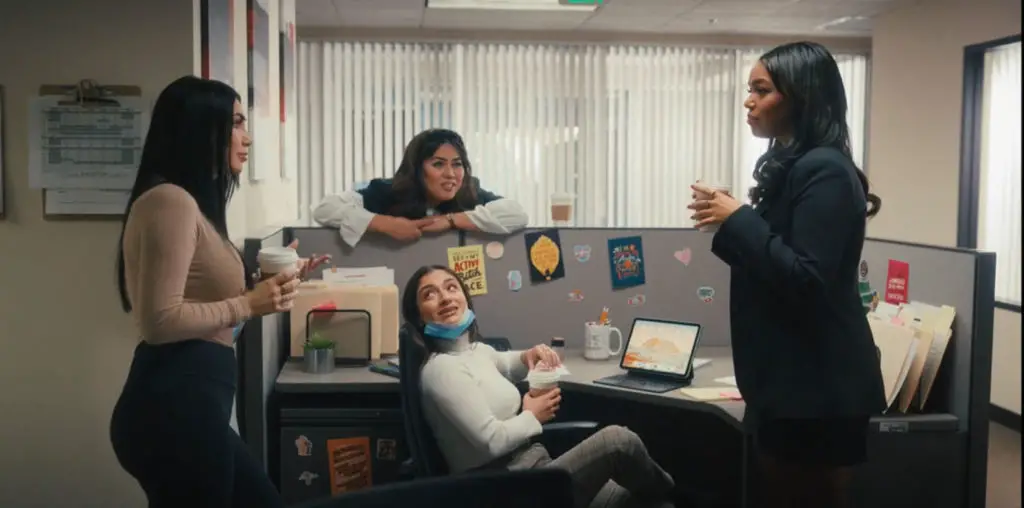
If Academy Awards were presented for hubris, the folks at Disney would sweep up the statuettes for “Saving Mr. Banks.” This over-extended self-congratulatory accolade offers a factually skewered version of the battle of wills that took place when Walt Disney sought to bring Australian-born British writer P.L. Travers’ book “Mary Poppins” to the screen.
The film takes place during a 1961 business visit by Travers to the Disney studio. The author would only allow Disney to create the film version if she had script approval. As presented in this film, Travers is a shrill virago who is thoroughly aghast at the Hollywood scene. She reacts to real and perceived slights with vituperative put-downs and reckless behavior – if she finds objects that irritate her (a bowl of pears in her hotel suite, the original Disney script of “Mary Poppins”), she throws them out of windows, with little regard to the people on the street below.
Intercut with Travers’ tantrums with the Disney razzmatazz team are flashbacks to the author’s childhood in early 20th century Australia. Travers (born Helen Goff) is shown as an unusually mature child that watches in concern as her immature, alcoholic father self-destructs before her eyes and her carpetbag-toting aunt arrives to save the day for the Goff family. But since the drunken Goff is played by eye candy Colin Farrell, we know he can’t be all that bad.
The film drives home the point that Travers’ excessive protection of the source material of “Mary Poppins” is based on the painful autobiographical elements that she laced into her story – and that Travers’ waspish rebukes of efforts to change the story for the film version are little more than psychological defense mechanisms to preserve what she cherished and lost as a child. Once wise old Walt Disney figures this out, he is able to come to some degree of understanding with Travers, allowing his version of “Mary Poppins” to proceed. Thus, the message of “Saving Mr. Banks” is too clear: good ol’ Uncle Walt put the British bitch in her place and went on to make a musical classic.
That’s all very nice, but “Saving Mr. Banks” overlooks some easily verifiable facts. For starters, Disney was not the only film producer seeing the rights to “Mary Poppins.” Travers had doubts that her book could be made into a film – and she was not a big fan of the Disney canon – but she allowed for “Mary Poppins” to be made into a one-shot live U.S. television production in 1949 for the “Studio One” anthology series, with Mary Wickes playing the title role in a non-musical version of the story. (Sadly, copies of that broadcast are not available for review at this time.)
“Saving Mr. Banks” is peppered with more mistakes. The film also insists that Disney and Travers never met prior to her visit to Hollywood – but according to Disney biographer Bob Thomas, Disney called on her at her London home years earlier as part of his two-decade-long campaign to secure the film rights. The film also gives the impression that Dick Van D**e was cast in “Mary Poppins” early in the pre-production – Thomas, in his book, notes that Van D**e was cast later in the process, after Julie Andrews was signed, and that only happened when Disney opted to make Travers’ middle-aged creation into a younger woman. (Mary Martin was actually the original choice for the film’s title role, but she turned it down.)
There is also a wild anachronism with the presence of a stuffed doll of Disney’s Winnie the Pooh in Travers’ hotel suite – several years before Disney put the A.A. Milne creation on the screen.
But the real problem here is creating one-dimensional versions of Travers and Disney that fail to consider the complexity of both individuals.
Emma Thompson plays Travers in a one-note stridency – her imperious attitude to everyone around her makes the character obnoxious and stupid. In reality, Travers was a complex and highly intelligent woman – the film makes no mention of her bisexuality and only the faintest of references to her deep interest in Zen Buddhism and her disastrous adoption of an Irish orphan. The film gives the impression that she relinquished the film rights to “Mary Poppins” only because she was facing poverty due to an evaporation of book royalties (the costs related to her adopted son’s legal problems following a drunk driving arrest are not mentioned in the film), and that she was a foolish shrew for attempting to control the focus of her world – the latter is an odd consideration, especially when male artists that attempt to do the same thing are almost always lauded for their integrity.
As for Disney, few people beyond the Disney studio will believe that the producer was the patient, grandfatherly sage portrayed by Tom Hanks. Unlike the holistic Disney in “Saving Mr. Banks,” the real Disney was not shy about playing hardball with Travers – to the point that he intentionally refused to invite her to the “Mary Poppins” premiere. (At her own instigation, she managed to secure an invitation.) It also doesn’t help that Hanks’ vocal imitation of Disney includes an on-again/off-again twang that makes him sound like Lyndon B. Johnson rather than the famous producer.
Travers feared that her literary legacy would be recklessly sentimentalized by Disney, and now it seems that her biography is also getting the Disneyfication treatment. Sadly, audiences have to swallow more than a spoonful of sugar to digest this blatantly phony movie.

Phil, you hit that one out of the park. I couldn’t believe how painful this blatant fake-a-thon was to watch. Fecal treacle from start to finish. Whoever in his circle encouraged the actor to take the part should’ve been more concerned with saving Mr Hanks.